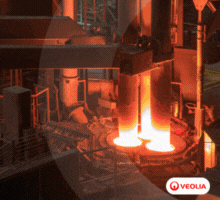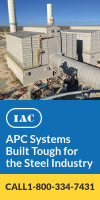worldsteel Provides Short Range Outlook for Steel Industry
10/05/2010 - The World Steel Association forecasts in its October 2010 short range outlook (SRO) for 2010 and 2011 that apparent steel use will increase by 13.1% to 1,272 million tonnes in 2010 after declining by 6.6% in 2009. This represents an improvement of 35 million tonnes over the April SRO for 2010, exceeding the pre-crisis peak of 1,222 million tonnes in 2007.
The World Steel Association (worldsteel) forecasts in its October 2010 short range outlook (SRO) for 2010 and 2011 that apparent steel use will increase by 13.1% to 1,272 million tonnes in 2010 after declining by 6.6% in 2009. This represents an improvement of 35 million tonnes over the April SRO for 2010, exceeding the pre-crisis peak of 1,222 million tonnes in 2007.
In 2011, world steel demand is forecast to grow by 5.3% to reach a record 1,340 million tonnes. The worldsteel Economics Committee met in Rio de Janeiro in September 2010 to discuss the October 2010 SRO.
“Our first SRO forecast after the economic crisis in 2009 suggested 8.4% growth in steel demand in 2010,” said Daniel Novegil, Chairman of the worldsteel Economics Committee. “We have now revised this figure up to 13.1%. This improved outlook is due to a better-than-expected forecast for the developed economies particularly the EU, NAFTA, and the CIS as well as the continued strong rebound in most emerging economies. This suggests a steady and stable steel recovery, and our current forecast does not foresee a double dip recession as feared by some.
"Despite the better-than-expected forecast for 2010, we are still cautious,” he continued. “Steel demand in the developed economies in 2011 will still be well below the pre-crisis peak level. The recovery so far has been mainly driven by the inventory cycle and government stimulus packages whose effects are now fading out. But, whether consumer and corporate spending will now pick up and continue the recovery momentum is yet to be seen. Recent economic indicators are giving us mixed signals and developments in the remaining part of this year and early next year must be watched carefully.”
China's apparent steel use in 2010 is expected to increase by 6.7% to 579 million tonnes, following an increase of 24.8% in 2009. While China showed an increase of 9.2% in apparent steel use during the period of January to August 2010, worldsteel forecasts that China's apparent steel use growth will slow down considerably in the remaining part of this year due to the Chinese government's effort to temper the real estate sector and ongoing production control. In 2011, the growth rate is expected to slow further to 3.5% with a weak real estate sector and the phasing out of stimulus packages. China will account for about 45% of world apparent steel use in 2011.
India's steel demand grew 7.5% during the crisis and is expected to grow by 8.2% and 13.6% in 2010 and 2011, respectively. With 68 million tonnes of apparent steel use in 2011, India will become the third largest steel using country in the world after China and the U.S. The country’s steel use will be 32% above its 2007 level.
In the NAFTA region, the U.S. had a 36.2% reduction in apparent steel use in 2009. Aided by stock building activities and a recovery in manufacturing, apparent steel use in the U.S. is expected to grow by 32.9% in 2010 and then 9.4% to 86.1 million tonnes in 2011, bringing it to 79.7% of the 2007 level. For NAFTA as a whole, apparent steel use will grow by 31.3% in 2010 and 8.7% in 2011.
In Central and South America, apparent steel use declined by 23.6% in 2009 but will grow by 28.2% in 2010, aided by a rebound of 34.6% in Brazil. In 2011, the region's apparent steel use will grow by 9.1% to reach 47.6 million tonnes, 14% higher than the 2007 level.
The EU economies had a 35.7% reduction in their apparent steel use in 2009 with Spain, Italy, and the U.K. especially hard hit due to the collapse of their construction sectors, according to the SRO. In 2010, the region will see an increase of 18.9% in its apparent steel use due to inventory rebuilding and strength in the export sector. In 2011, an increase in real use is expected to drive the region's steel demand to grow by 5.7% to reach 147.4 million tonnes, bringing it back to 75% of the 2007 peak.
Japan, which experienced a decline of 32.3% in apparent steel use in 2009, will see its steel use increase by 19.1% in 2010. In 2011, its steel demand is expected to fall by 1.4% due to tight fiscal policy, strong Yen, and weakening of its major steel using sectors. This brings Japan's apparent steel use in 2011 to 62.0 million tonnes, 76% of 2007 level.
Apparent steel use in the CIS region fell 28.3% in 2009, with a decline of 43.0% in Ukraine. In 2010, apparent steel use in the CIS region is expected to grow by 26.5% and then by 11.1% in 2011. This brings the region's apparent steel use in 2011 to 89% of the 2007 peak.
Turkey, which experienced a 16% decline in apparent steel use in 2009, will see a recovery of 20.5% in 2010, followed by a further 10.7% growth in 2011 to reach 24.1 million tonnes, which will bring its apparent steel use back to the 2007 peak level.
The MENA region was stable in 2009 despite the fall in oil prices and collapse in the construction market, which was offset by an expansionary fiscal stance in the GCC countries, Egypt, and Iran, the report noted. The region recorded 0.4% growth in 2009 and expected to show 5.9% and 5.3% growth in apparent steel use in 2010 and 2011, respectively. This will bring apparent steel use in the MENA region to 65.7 million tonnes, which is 17% above the 2007 level.
The World Steel Association (worldsteel) is one of the largest industry associations in the world, representing approximately 180 steel producers (including 19 of the world's 20 largest steel companies), national and regional steel industry associations, and steel research institutes. worldsteel members produce around 85% of the world's steel.
Apparent steel use reflects the deliveries of steel to the marketplace from the domestic steel producers as well as from importers. This differs from real steel use, which takes into account steel delivered to or drawn from inventories.



.jpg?lang=en-US&ext=.jpg)
-(1).gif?width=220&height=200&mediaprotectionhash=8011a71ede637cd523c67b1296fc49e6151560fde821a46f29cc85998cc76615&ext=.gif)



